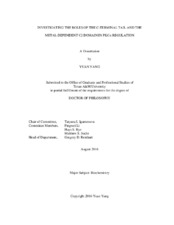| dc.contributor.advisor | Igumenova, Tatyana I | |
| dc.creator | Yang, Yuan | |
| dc.date.accessioned | 2017-03-02T16:43:15Z | |
| dc.date.available | 2018-08-01T05:58:42Z | |
| dc.date.created | 2016-08 | |
| dc.date.issued | 2016-07-18 | |
| dc.date.submitted | August 2016 | |
| dc.identifier.uri | https://hdl.handle.net/1969.1/158924 | |
| dc.description.abstract | Protein kinase C (PKC) isoenzymes sit in the crossroad of numerous signaling pathways involved in cellular functions such as proliferation, differentiation, migration and survival. The dysregulation of PKCs have been shown to associate with human diseases including cancers, cardiovascular diseases and neurodegenerative diseases. However, the knowledge of PKC regulation is still limited. The objective of this dissertation is to determine the roles of the PKCa C-terminal tail and the C2 regulatory domain in its maturation, activation and down-regulation.
The C-terminal V5 domain of PKC contains the least conserved sequence among the isoenzymes. In this study, nuclear magnetic resonance (NMR) and circular dichroism are used to show that the isolated V5 domain is intrinsically disordered in solution. A detailed characterization is provided for the V5 domain’s secondary structural preference, dynamic properties and propensity to interact with a hydrophobic environment.
NMR techniques are used to demonstrate that the PKCa C2 domain interacts with the V5 domain. A structural model for the C2–V5 complex is determined. In addition, NMR-detected binding studies reveal that V5 and calcium interact with C2 cooperatively. Mutations that disrupt the C2–V5 interface altered both the conformation of full-length PKCa and the kinetics of membrane translocation. These results indicate that C2-V5 interaction plays an essential role in PKC regulation, through its contribution to both autoinhibition and activation. Furthermore, the V5 domain is shown to directly interact with the peptidyl-prolyl isomerase Pin1. The V5–Pin1 interaction is observed to be highly specific, non-catalytic, and is enhanced by the avidity from bivalent binding. These data provide insights into a novel mechanism for the Pin1-mediated down-regulation process of PKCs.
The metal-dependent membrane interactions of the C2 domain are studied with cadmium as structural surrogate and the results compared to other divalent metals. Conformational dynamics change induced by calcium binding is detected for regions connecting to other PKC domains. These results reveal specific roles of calcium ion during membrane interaction and conformational rearrangement of PKC.
Together, these data contribute to our understanding of PKC regulation with concerted intramolecular contacts and complex intermolecular interactions, which can help to develop isoenzyme-specific agents to modulate PKC activity. | en |
| dc.format.mimetype | application/pdf | |
| dc.language.iso | en | |
| dc.subject | Protein kinase C | en |
| dc.subject | intrinsically disordered protein (IDP) | en |
| dc.subject | V5 domain | en |
| dc.subject | nuclear magnetic resonance (NMR) | en |
| dc.subject | structure | en |
| dc.subject | dynamics | en |
| dc.subject | peptidyl-prolyl isomerase Pin1 | en |
| dc.subject | C2 domain | en |
| dc.subject | metal | en |
| dc.subject | membrane binding | en |
| dc.title | Investigating the Roles of the C-terminal Tail and the Metal-dependent C2 Domain in PKCa Regulation | en |
| dc.type | Thesis | en |
| thesis.degree.department | Biochemistry and Biophysics | en |
| thesis.degree.discipline | Biochemistry | en |
| thesis.degree.grantor | Texas A & M University | en |
| thesis.degree.name | Doctor of Philosophy | en |
| thesis.degree.level | Doctoral | en |
| dc.contributor.committeeMember | Li, Pingwei | |
| dc.contributor.committeeMember | Rye, Hays S | |
| dc.contributor.committeeMember | Sachs, Matthew S | |
| dc.type.material | text | en |
| dc.date.updated | 2017-03-02T16:43:15Z | |
| local.embargo.terms | 2018-08-01 | |
| local.etdauthor.orcid | 0000-0002-9538-6369 | |


